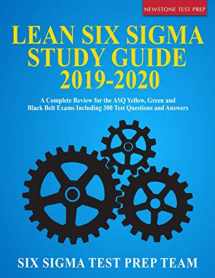
Lean Six Sigma Study Guide 2019-2020: A Complete Review for the ASQ Yellow, Green and Black Belt Exams Including 300 Test Questions and Answers
ISBN-13:
9781687238078
ISBN-10:
1687238073
Author:
Six Sigma Test Prep Team
Publication date:
2019
Publisher:
Independently published
Format:
Paperback
431 pages
FREE US shipping
Book details
ISBN-13:
9781687238078
ISBN-10:
1687238073
Author:
Six Sigma Test Prep Team
Publication date:
2019
Publisher:
Independently published
Format:
Paperback
431 pages
Summary
Lean Six Sigma Study Guide 2019-2020: A Complete Review for the ASQ Yellow, Green and Black Belt Exams Including 300 Test Questions and Answers (ISBN-13: 9781687238078 and ISBN-10: 1687238073), written by authors
Six Sigma Test Prep Team, was published by Independently published in 2019.
With an overall rating of 4.4 stars, it's a notable title among other
Certification & Development
(Schools & Teaching, Study Guides, Study Guides & Workbooks) books. You can easily purchase or rent Lean Six Sigma Study Guide 2019-2020: A Complete Review for the ASQ Yellow, Green and Black Belt Exams Including 300 Test Questions and Answers (Paperback) from BooksRun,
along with many other new and used
Certification & Development
books
and textbooks.
And, if you're looking to sell your copy, our current buyback offer is $0.3.
Description
The exam questions for Yellow, Green and Black Belts have changed as of 2019. While other shorter books have around 60 questions, this guide includes 300 questions so that students are fully prepared before taking the exam.
This guide includes a complete review of theory that students will need to know. Furthermore, questions and answers are divided by Belt Type. The Yellow, Green and Black Belts have 100 questions each, with a total of 300 questions in this book.
Consider the Table of Contents below and you will see that this guide stands out from the rest.


We would LOVE it if you could help us and other readers by reviewing the book
Book review

Congratulations! We have received your book review.
{user}
{createdAt}
by {truncated_author}


